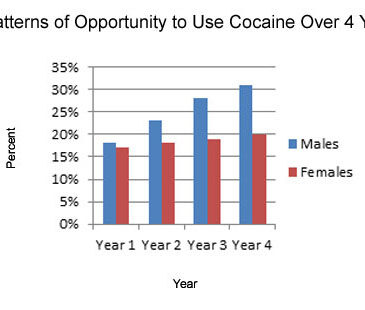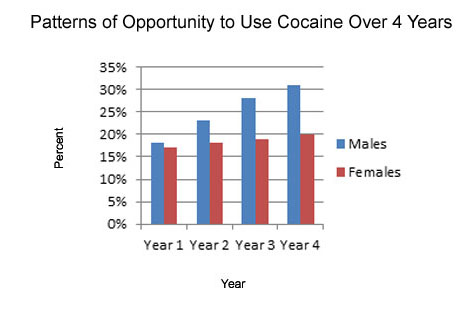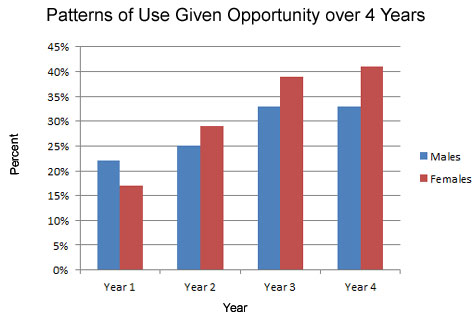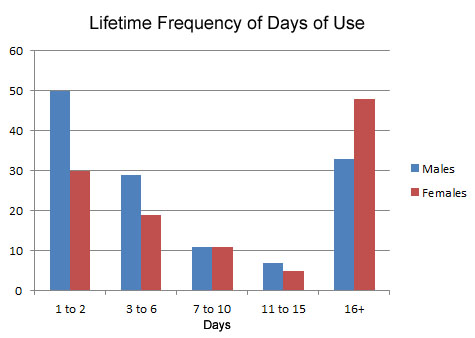Recent studies reveal that cocaine use is more prevalent among young adults compared to other user population groups (Substance Abuse and Mental Health Administration (SAMHSA), 2008). Estimates of past-year cocaine use among young adults have steadily increased over the last ten years (Kasperski et al., 2011). However, male and female college students might be different in terms of cocaine use in some important ways. While some studies cite higher prevalence rates of cocaine use in young males, others cite riskier behavior in female cocaine users, suggesting that young females might be more susceptible than males to developing serious problems with cocaine (Kasperski et al., 2011). This week’s STASH features a study that analyzed gender differences in prevalence of cocaine exposure and actual cocaine use in a longitudinal sample of 1,253 college students.
Methods
- The researchers administered annual questionnaires from the National Survey on Drug Use and Health to track a sample of college students throughout their four years at a large, mid-Atlantic university.
- The analyses examined frequency of cocaine use and DSM-IV criteria for cocaine dependence in the sample of students. Analyses covered two additional kinds of data: age at first offer of cocaine and age at first use of cocaine.
- Age at first offer of cocaine was operationalized as the participant’s age during the first assessment in which an offer was reported. For individuals who were offered cocaine prior to Year 1, age at first offer was captured by self-report.
- Age of first use of cocaine was computed similarly.
- 1,253 college students took part in the study (70.8% White; 48.5% Male). Follow-up rates ranged from 91.1% in Year 2 to 87.6% in Year 4. Researchers excluded 192 students because of missing data.
- Data from the first four years of college were analyzed to detect changes over time and possible gender differences.
Results
Gender differences appeared in opportunities to use and patterns of actual usage.
- As displayed in Figure 1, with the exception of the first year of college, males reported significantly higher opportunities to use than women (41% vs. 31% overall). Males reported an increase in exposure opportunity over time (Year 1 to Year 2: p <.03; Year 2 to Year 3: p=.005), while females did not. This suggests a gender difference in opportunities to use.
- However, there was no significant difference between males and females in the sub-sample (n=584) of those who used cocaine, given the opportunity. Both genders showed an overall rate of 37%. While men were more likely to be presented with opportunities to use cocaine, men and women were equal in terms of use when given the opportunity to use.
- Women tended to use cocaine more frequently than men, both in terms of lifetime use as of Year 4 (27.78 days vs. 12.75 days during Year 4) and during the peak year of use (18.39 days vs. 8.83 days). For females, annual changes in frequency of cocaine use were statistically significant from Year 1 to Year 2 (p=.001) and Year 2 to Year3 (p=.009).
- Women were more likely than men to meet DSM-IV criteria for dependence (9.3% vs. 2.5%).
Limitations
- The authors note several limitations, including that their study cannot rule out the possibility of gender differences in reporting dependence symptoms. Males may report fewer symptoms that would meet DSM-IV criteria for dependence.
- They also note that the study’s findings have limited generalizability to other types of colleges and geographic regions.
Discussion
This study’s longitudinal design and high follow-up rate is a strong start for identifying patterns of risky behavior. The results suggest that there are possible gender differences in how college students experience opportunities for use of illicit drugs, in line with previous studies. The results help resolve apparent paradoxes in gender-based patterns of cocaine use. Men reported more opportunities to use cocaine than women. Research that uncovers the settings in which young men typically find opportunities to use cocaine might inform primary prevention efforts. However, among the smaller sample of students who actually used cocaine given the opportunity, there was no significant difference between the two genders. Women who chose to use cocaine used it more frequently and were more likely to meet DSM-IV criteria for dependence. Animal studies have suggested sex differences in endocrine-related cocaine response (Kasperski et al., 2011). Early interventions targeted for women could emphasize these differences by teaching girls about their potential heightened sensitivity to cocaine use. More research remains to be done in specific gender differences in developing substance abuse dependence.
– Kat Belkin
What do you think? Please use the comment link below to provide feedback on this article.
References
Kasperski, S. J., Vincent, K.B., Caldeira, K.M., Garnier-Dykstra, L.M., O’Grady, K.E., Arria, A.M. (2011). “College students’ use of cocaine: Results from a longitudinal study.” Addictive Behaviors 36, 408-4011.
Substance Abuse and Mental Health Services Administration (2008). Results from the 2007 National Survey on Drug Use and Health: National findings (DHHS Publication No. SMA 08-4343). Rockville, MD: Office of Applied Studies.








Trish Wright September 7, 2011
I think women are more likely to use cocaine for weight control.
Sue September 12, 2011
#1 — incorrect use of temporal modifiers. In this case “while” as in “While men were more likely to be presented with opportunities to use cocaine …” Should be easy enough to change the “whiles” to the correct “although”.
#2 — an 88% survival from year 1 to year 4 deserves a better explanation of the recruitment procedure — perhaps the school in question is a nunnery.
#3 — Just a handful of users (10 – 19) and check out the cryptic and hidden bote to Table 1, In every year there were individuals who used cocaine without being given the opportunity to use in that same year;” tough to trust the data.
Best,
Sue